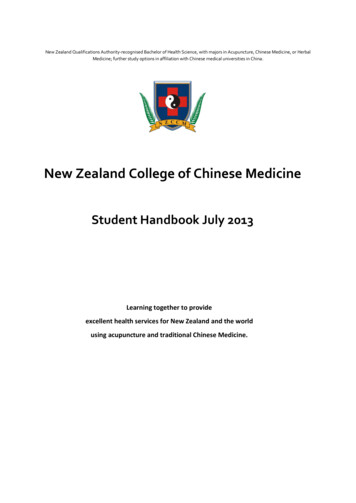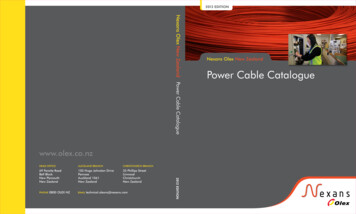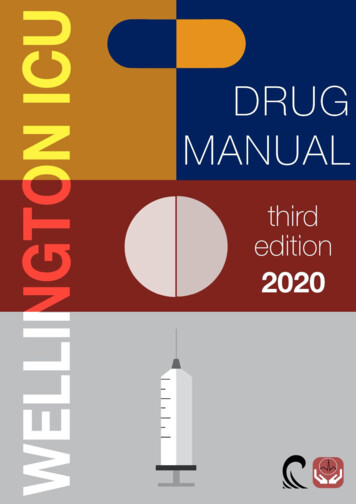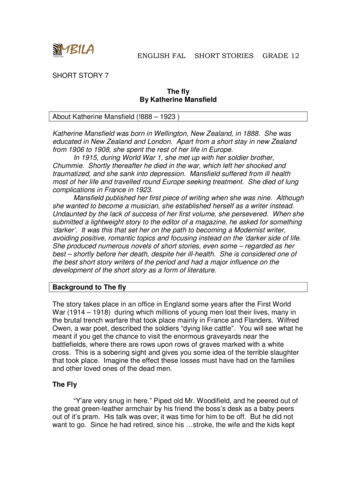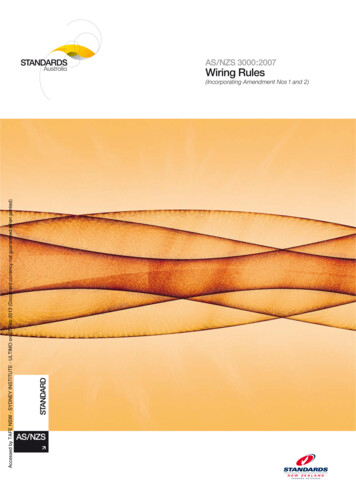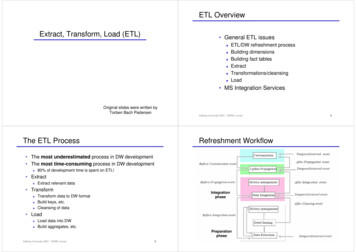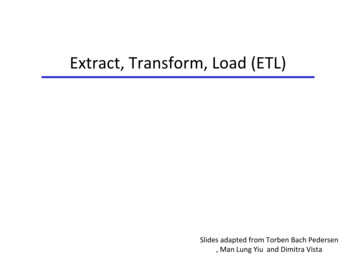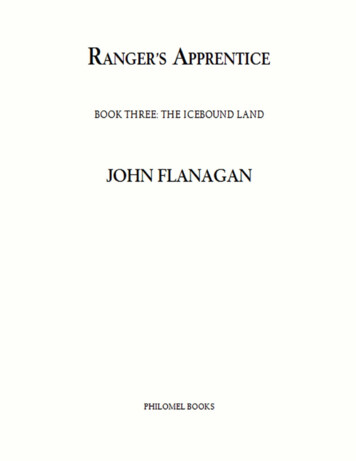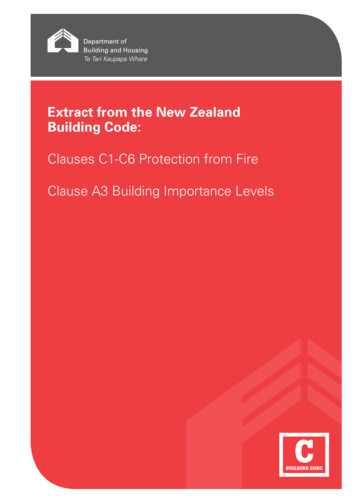
Transcription
Extract from the New ZealandBuilding Code:Clauses C1-C6 Protection from FireClause A3 Building Importance Levels
This document contains extracts of the New Zealand Building Code Clauses C1–C6 Protection fromFire and A3 Building Importance Levels. The full Building Code is contained in Schedule 1 of theBuilding Regulations 1992. These regulations can be downloaded from www.legislation.govt.nzPeople using this document should check on a regular basis whether new versions have beenpublished. The current version can be downloaded from www.dbh.govt.nz/compliance-documentsUsers should make themselves familiar with the preface to the New Zealand Building CodeHandbook, which describes the building controls system in New Zealand and the Building Code.Defined words (italicised in the text) are explained in the Building Code Clause A2 Interpretation.Enquiries about the content of this document should be directed to:Department of Building and HousingPO Box 10-729, Wellington.Telephone 0800 242 243Fax 04 494 0290Email: info@dbh.govt.nzRegulations are available from www.legislation.govt.nz
Clauses C1, C2, C3, C4, C5, C6N E W Z E A L A N D BU I L D I N G C O D EC1—Objectives of clauses C2to C6 (protection from fire)Limit on applicationProvisionsThe objectives of clauses C2 to C6 are to:(a) safeguard people from an unacceptablerisk of injury or illness caused by fire,(b) protect other property from damagecaused by fire, and(c) facilitate firefighting and rescueoperations.D epa r t m en t o f Bui l d ing a n d H ous ing – 10 A p r i l 2 012I1
N E W Z E A L A N D BU I L D I N G C O D EClauses C1, C2, C3, C4, C5, C6C2—Prevention of fireoccurringProvisionsFunctional requirementC2.1 Fixed appliances using controlledcombustion and other fixed equipmentmust be designed, constructed, andinstalled in buildings in a way that reducesthe likelihood of illness or injury due tofire occurring.PerformanceC2.2 The maximum surface temperatureof combustible building materials closeto fixed appliances using controlledcombustion and other fixed equipmentwhen operating at their design level mustnot exceed 90 C.C2.3 Fixed appliances using controlledcombustion and other fixed equipmentmust be designed, constructed andinstalled so that there is a low probabilityof explosive or hazardous conditionsoccurring within any spaces in or aroundthe building that contains the appliances.2ID epa r t m en t o f Bui l d ing a n d H ous ing – 10 A p r i l 2 012Limit on application
Clauses C1, C2, C3, C4, C5, C6N E W Z E A L A N D BU I L D I N G C O D EC3—Fire affecting areas beyondthe fire sourceProvisionsLimit on applicationFunctional requirementC3.1 Buildings must be designed andconstructed so that there is a lowprobability of injury or illness to personsnot in close proximity to a fire source.C3.2 Buildings with a building heightgreater than 10 m where upper floorscontain sleeping uses or other propertymust be designed and constructed so thatthere is a low probability of external verticalfire spread to upper floors in the building.Clause C3.2 does not apply toimportance level 1 buildings.C3.3 Buildings must be designed andconstructed so that there is a lowprobability of fire spread to other propertyvertically or horizontally across a relevantboundary.D epa r t m en t o f Bui l d ing a n d H ous ing – 10 A p r i l 2 012I3
N E W Z E A L A N D BU I L D I N G C O D EClauses C1, C2, C3, C4, C5, C6C3—Fire affecting areas beyondthe fire source (continued)ProvisionsLimit on applicationPerformanceC3.4 (a) materials used as internal surfacelinings in the following areas of buildingsmust meet the performance criteria specifiedbelow:Area of building4IClause C3.4 does not apply todetached dwellings, within householdunits in multi-unit dwellings, oroutbuildings and ancillary buildings.Performance determined under conditions describedin ISO 9705: 1993Buildings not protectedwith an automatic firesprinkler systemBuildings protectedwith an automatic firesprinkler systemWall/ceiling materials insleeping areas where careor detention is providedMaterial Group Number 1-SMaterial Group Number1 or 2Wall/ceiling materials inexitwaysMaterial Group Number 1-SMaterial Group Number1 or 2Wall/ceiling materials inall occupied spaces inimportance level 4 buildingsMaterial Group Number 1-SMaterial Group Number1 or 2Internal surfaces of ductsfor HVAC systemsMaterial Group Number 1-SMaterial Group Number1 or 2Ceiling materials in crowdand sleeping uses excepthousehold units andwhere care or detentionis providedMaterial Group Number1-S or 2-SMaterial Group Number1 or 2Wall materials in crowdand sleeping uses excepthousehold units andwhere care or detentionis providedMaterial Group Number1-S or 2-SMaterial Group Number1, 2, or 3Wall/ceiling materials inoccupied spaces in all otherlocations in buildings,including household unitsMaterial Group Number1, 2, or 3Material Group Number1, 2, or 3External surfaces of ductsfor HVAC systemsMaterial Group Number1, 2, or 3Material Group Number1, 2, or 3Acoustic treatment and pipeinsulation within airhandlingplenums in sleeping usesMaterial Group Number1, 2, or 3Material Group Number1, 2, or 3D epa r t m en t o f Bui l d ing a n d H ous ing – 10 A p r i l 2 012
Clauses C1, C2, C3, C4, C5, C6N E W Z E A L A N D BU I L D I N G C O D EC3—Fire affecting areas beyondthe fire source (continued)ProvisionsLimit on application(b) floor surface materials in thefollowing areas of buildings mustmeet the performance criteriaspecified below:Area of buildingMinimum critical radiant flux when tested toISO 9239-1: 2010Buildings not protectedwith an automatic firesprinkler systemBuildings protectedwith an automatic firesprinkler systemSleeping areas andexitways in buildings wherecare or detention isprovided4.5 kW/m22.2 kW/m2Exitways in all otherbuildings2.2 kW/m22.2 kW/m2Firecells accommodatingmore than 50 persons2.2 kW/m21.2 kW/m2All other occupied spacesexcept household units1.2 kW/m21.2 kW/m2(c) suspended flexible fabrics andmembrane structures used in theconstruction of buildings must haveproperties resulting in a lowprobability of injury or illness topersons not in close proximity toa fire source.C3.5 Buildings must be designed andconstructed so that fire does not spreadmore than 3.5 m vertically from the firesource over the external cladding ofmulti-level buildings.C3.6 Buildings must be designed andconstructed so that in the event of fire inthe building the received radiation at therelevant boundary of the property doesnot exceed 30 kW/m2 and at a distance of1 m beyond the relevant boundary of theproperty does not exceed 16 kW/m2.D epa r t m en t o f Bui l d ing a n d H ous ing – 10 A p r i l 2 012I5
N E W Z E A L A N D BU I L D I N G C O D EClauses C1, C2, C3, C4, C5, C6C3—Fire affecting areas beyondthe fire source (continued)ProvisionsC3.7 External walls of buildings that arelocated closer than 1 m to the relevantboundary of the property on which thebuilding stands must either:(a) be constructed from materials whichare not combustible building materials, or(b) for buildings in importance levels 3 and4, be constructed from materials that, whensubjected to a radiant flux of 30 kW/m2, donot ignite for 30 minutes, or(c) for buildings in Importance Levels 1 and2, be constructed from materials that, whensubjected to a radiant flux of 30 kW/m2, donot ignite for 15 minutes.C3.8 Firecells located within 15 m of arelevant boundary that are not protected byan automatic fire sprinkler system, and thatcontain a fire load greater than 20 TJ or thathave a floor area greater than 5,000 m2must be designed and constructed so thatat the time that firefighters first apply waterto the fire, the maximum radiation flux at1.5 m above the floor is no greater than4.5 kW/m2 and the smoke layer is not lessthan 2 m above the floor.C3.9 Buildings must be designed andconstructed with regard to the likelihoodand consequence of failure of any firesafety system intended to control firespread.6ID epa r t m en t o f Bui l d ing a n d H ous ing – 10 A p r i l 2 012Limit on application
Clauses C1, C2, C3, C4, C5, C6N E W Z E A L A N D BU I L D I N G C O D EC4—Movement to place of safetyProvisionsLimit on applicationFunctional requirementC4.1 Buildings must be provided with:(a) effective means of giving warning offire, and(b) visibility in escape routes complyingwith clause F6.C4.2 Buildings must be provided withmeans of escape to ensure that there isa low probability of occupants of thosebuildings being unreasonably delayed orimpeded from moving to a place of safetyand that those occupants will not sufferinjury or illness as a result.PerformanceC4.3 The evacuation time must allowoccupants of a building to move to a placeof safety in the event of a fire so thatoccupants are not exposed to any ofthe following:(a) a fractional effective dose of carbonmonoxide greater than 0.3:(b) a fractional effective dose of thermaleffects greater than 0.3:(c) conditions where, due to smokeobscuration, visibility is less than 10 mexcept in rooms of less than 100 m2 wherevisibility may fall to 5 m.C4.4 Clause C4.3(b) and (c) do not applywhere it is not possible to expose morethan 1 000 occupants in a firecell protectedwith an automatic fire sprinkler system.C4.5 Means of escape to a place of safetyin buildings must be designed andconstructed with regard to the likelihoodand consequence of failure of any firesafety systems.D epa r t m en t o f Bui l d ing a n d H ous ing – 10 A p r i l 2 012I7
N E W Z E A L A N D BU I L D I N G C O D EClauses C1, C2, C3, C4, C5, C6C5—Access and safety forfirefighting operationsLimit on applicationProvisionsFunctional requirementC5.1 Buildings must be designed andconstructed so that there is a lowprobability of firefighters or otheremergency services personnel beingdelayed in or impeded from assistingin rescue operations and performingfirefighting operations.C5.2 Buildings must be designed andconstructed so that there is a lowprobability of illness or injury to firefightersor other emergency services personnelduring rescue and firefighting operations.PerformanceC5.3 Buildings must be provided withaccess for fire service vehicles to ahard-standing from which there is anunobstructed path to the building within20 m of:(a) the firefighter access into the building,andPerformance requirements inclauses C5.3 to C5.8 do notapply to backcountry huts,detached dwellings, withinhousehold units in multi-unitdwellings, or to outbuildings,and ancillary buildings.(b) the inlets to automatic fire sprinklersystems or fire hydrant systems, wherethese are installed.C5.4 Access for fire service vehicles inaccordance with clause C5.3 must beprovided to more than 1 side of firecellsgreater than 5,000 m2 in floor area thatare not protected by an automatic firesprinkler system.C5.5 Buildings must be provided with themeans to deliver water for firefighting toall parts of the building.C5.6 Buildings must be designed andconstructed in a manner that will allowfirefighters, taking into account thefirefighters’ personal protective equipmentand standard training, to:(a) reach the floor of fire origin,(b) search the general area of fire origin,and(c) protect their means of egress.8ID epa r t m en t o f Bui l d ing a n d H ous ing – 10 A p r i l 2 012
Clauses C1, C2, C3, C4, C5, C6N E W Z E A L A N D BU I L D I N G C O D EC5—Access and safety forfirefighting operations (continued)ProvisionsLimit on applicationC5.7 Buildings must be provided withmeans of giving clear information to enablefirefighters to:(a) establish the general location of thefire,(b) identify the fire safety systemsavailable in the building, and(c) establish the presence of hazardoussubstances or process in the building.C5.8 Means to provide access for andsafety of firefighters in buildings must bedesigned and constructed with regard tothe likelihood and consequence of failureof any fire safety systems.D epa r t m en t o f Bui l d ing a n d H ous ing – 10 A p r i l 2 012I9
N E W Z E A L A N D BU I L D I N G C O D EClauses C1, C2, C3, C4, C5, C6C6—Structural stabilityProvisionsFunctional requirementC6.1 Structural systems in buildings mustbe constructed to maintain structuralstability during fire so that there is:(a) a low probability of injury or illness tooccupants,(b) a low probability of injury or illness tofire service personnel during rescue andfirefighting operations, and(c) a low probability of direct orconsequential damage to adjacenthousehold units or other property.PerformanceC6.2 Structural systems in buildings thatare necessary for structural stability in firemust be designed and constructed so thatthey remain stable during fire and after firewhen required to protect other propertytaking into account:(a) the fire severity,(b) any automatic fire sprinkler systemswithin the buildings,(c) any other active fire safety systems thataffect the fire severity and its impact onstructural stability, and(d) the likelihood and consequence offailure of any fire safety systems that affectthe fire severity and its impact on structuralstability.C6.3 Structural systems in buildings thatare necessary to provide firefighters withsafe access to floors for the purpose ofconducting firefighting and rescueoperations must be designed andconstructed so that they remain stableduring and after fire.C6.4 Collapse of building elements thathave lesser fire resistance must not causethe consequential collapse of elementsthat are required to have a higher fireresistance.10ID epa r t m en t o f Bui l d ing a n d H ous ing – 10 A p r i l 2 012Limit on application
Clauses C1, C2, C3, C4, C5, C6N E W Z E A L A N D BU I L D I N G C O D ECLAUSE A3—BUILDING IMPORTANCELEVELSFor the purposes of clause C, a building has one of the importance levels set out below:ImportancelevelDescription of building typeSpecific structureImportancelevel 1Buildings posing low risk to humanlife or the environment, or a loweconomic cost, should the buildingfail. These are typically small nonhabitable buildings, such as sheds,barns, and the like, that are notnormally occupied, though they mayhave occupants from time to time. Ancillary buildings not forhuman habitation Minor storage facilities Backcountry hutsImportancelevel 2Buildings posing normal risk tohuman life or the environment, or anormal economic cost, should thebuilding fail. These are typicalresidential, commercial, andindustrial buildings. All buildings and facilitiesexcept those listed inimportance levels 1, 3, 4,and 5Importancelevel 3Buildings of a higher level of societalbenefit or importance, or with higherlevels of risk-significant factors tobuilding occupants. These buildingshave increased performancerequirements because they mayhouse large numbers of people,vulnerable populations, or occupantswith other risk factors, or fulfil a roleof increased importance to the localcommunity or to society in general. Buildings where more than 300people congregate in 1 area Buildings with primary school,secondary school, or daycarefacilities with a capacity greaterthan 250 Buildings with tertiary or adulteducation facilities with acapacity greater than 500 Health care facilities with acapacity of 50 or moreresidents but not havingsurgery or emergencytreatment facilities Jails and detention facilities Any other building with a capacityof 5 000 or more people Buildings for power generatingfacilities, water treatment forpotable water, wastewatertreatment facilities, and otherpublic utilities facilities notincluded in importance level 4D epa r t m en t o f Bui l d ing a n d H ous ing – 10 A p r i l 2 012I11
N E W Z E A L A N D BU I L D I N G C O D EClauses C1, C2, C3, C4, C5, C6CLAUSE A3—BUILDING IMPORTANCELEVELS (continued)ImportancelevelDescription of building typeImportancelevel 3(continued)Importancelevel 4Specific structure Buildings not included inimportance level 4 or 5containing sufficient quantitiesof highly toxic gas or explosivematerials capable of causingacutely hazardous conditionsthat do not extend beyondproperty boundariesBuildings that are essential topost-disaster recovery or associatedwith hazardous facilities. Hospitals and other health carefacilities having surgery oremergency treatment facilities Fire, rescue, and policestations and emergency vehiclegarages Buildings intended to be usedas emergency shelters Buildings intended by theowner to contribute toemergency preparedness, or tobe used for communication,and operation centres in anemergency, and other facilitiesrequired for emergencyresponse Power generating stations andother utilities required asemergency backup facilities forimportance level 3 structures Buildings housing highly toxicgas or explosive materialscapable of causing acutelyhazardous conditions thatextend beyond propertyboundaries Aviation control towers, airtraffic control centres, andemergency aircraft hangars Buildings having criticalnational defence functions Water treatment facilitiesrequired to maintain waterpressure for fire suppression12ID epa r t m en t o f Bui l d ing a n d H ous ing – 10 A p r i l 2 012
Clauses C1, C2, C3, C4, C5, C6N E W Z E A L A N D BU I L D I N G C O D ECLAUSE A3—BUILDING IMPORTANCELEVELS (continued)ImportancelevelDescription of building typeImportancelevel 4(continued)Importancelevel 5Specific structure Ancillary buildings (including,but not limited to, communicationtowers, fuel storage tanks orother structures housing orsupporting water or otherfire suppression material orequipment) required foroperation of importance level 4structures during an emergencyBuildings whose failure posescatastrophic risk to a large area(eg, 100 km2) or a large number ofpeople (eg, 100 000). Major dams Extremely hazardous facilitiesD epa r t m en t o f Bui l d ing a n d H ous ing – 10 A p r i l 2 012I13
Handbook, which describes the building controls system in New Zealand and the Building Code. Defined words (italicised in the text) are explained in the Building Code Clause A2 Interpretation. Enquiries about the content of this document should be directed to: . C6
